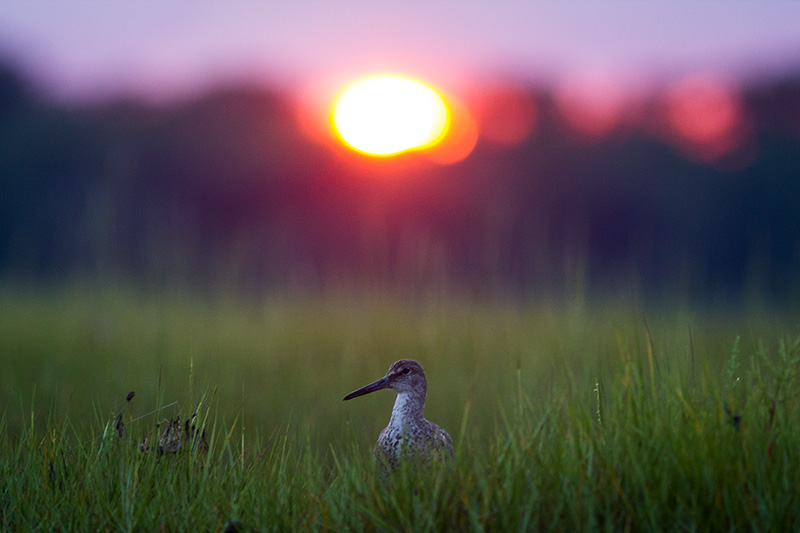Learning to absorb and refract the world around me.
Recently, I’ve covered a lot of ground with my camera and binoculars. I look for wildlife, sometimes idly, often for work. This is rarely smooth. I move too fast, I miss things, I get bored, I leave my memory card in my truck. I find a bird, but end up tangled in straps, frantic, as the wary fowl takes stock of me and moves on, to be found another day by somebody more discreet.
When it does work out, it’s usually because I’ve stopped to let a crucial moment pass. A plover stirs on its nest, a frog stills its voice, or a deer freezes mid-bite — they decide what to make of me.
If I’m lucky, the animal remains utterly indifferent. I’ll get a good long look. If I’m luckier, I’ll go home with a good picture, to reflect on and share. The prospect of getting a memorable shot, though (and of screwing one up), sometimes overrides the memorability of the experience itself.
I thought of this recently as I “liked” a photo from a popular, nature-themed social media account. It bore the caption, “We barely slept that weekend but got some amazing content! Aren’t those the best kind of weekends?”
I wonder. Photography can be a black hole of attention, and I am drawn outside in large part because of the clarity and focus that nature brings to a cluttered brain. What happens when you set out with the objective of producing good content? And what happens if you fail?
For one thing, you might end up as content, unintentionally, by getting clobbered. My browsing history overflows with pictures and videos of deeply absorbed photographers being charged or chomped by wild beasts — not to mention regular news of cliffside selfies gone awry, ancient rock formations toppled by aggressive photo ops, and onward down the spiral of park ranger nightmares.
I’m not a Luddite. Those are tabloid stories, and it’s not like the impulse toward visual trophy seeking is new — 12 decades ago, cutting-edge wildlife photographer Richard Kearton crouched uncomfortably inside a specially taxidermied ox, making an hours-long bid to gain the trust of a nesting skylark. He would later find that camouflage fabric worked just as well. Perhaps, though, the profusion of camera technology, and the speed with which photos can be taken and shared, has dulled our instinct to wait and see. I’ve been in a scrum of local wildlife photographers staking out a sleepy screech owl, when, between the red-carpet clatter of shutters, someone sighs, and says something like, “I wish it would do something.”
An impatient photographer at a scene like this might, for instance, fasten a dead vole to a fishing rod, and cast it in the direction of the owl, triggering a dramatic swoop and a bloody feast. This is frowned upon, because it habituates the owl to feeding, and, I think, because it so egregiously short-circuits the relationship between wild animals and people. It feels like cheating, even if setting up a forest of tripods in a suburban park doesn’t exactly feel like a National Geographic expedition, either.
The impulse to encapsulate something wild in a single frame is sometimes so strong that it tramples over reality — as when the British Natural History Museum retracted this year’s top wildlife photography prize, after experts determined that the giant anteater in the winning photo was a taxidermied model from a park visitor center.
The photo, it turned out, was a quite a bit more memorable than the experience.
I love to sit in creaky wooden bird blinds and wonder at the marsh mists. On crowded mornings, I sometimes also wonder about the hundred thousand dollars that would disappear should the blind — and the camera gear of all the photographers with me — topple suddenly into the water. A dozen giant lenses, each the cash equivalent of a late-model sedan, bubbling slowly down to the wet muck.
I have a cheap lens, and so I usually phrase this as a joke, and the photographers probably have insurance, but if they didn’t, I wonder if we might gain some perspective from the loss. The impulse to zoom in — to crop, to sharpen, to render in exquisite detail — can often upstage wider details abouts what makes the moment special, and specific.
I find that binoculars are a good intermediary. They enhance the power of the naked eye, but they hone a moment rather than trying to cast a net over it. I also keep my eyes peeled for new elements in the landscape, even if they aren’t charismatic. The ecosystem contextualizes the creatures it contains, and the more I learn about it, the more I can take the animal out of my snapshot and set it down in the breathing world.
It strikes me that although we’ve generally stopped shooting birds to make hats, or harvesting seal pups for their pelts, we might still be involved in a utilitarian transaction with wildlife when we trade images of it for psychological gratification, in whatever form. I don’t know what to do with this sentiment, except to put down my camera once in a while and drink it all in, knowing that I’ll have nothing but my memory to take home with me.


Leave a reply